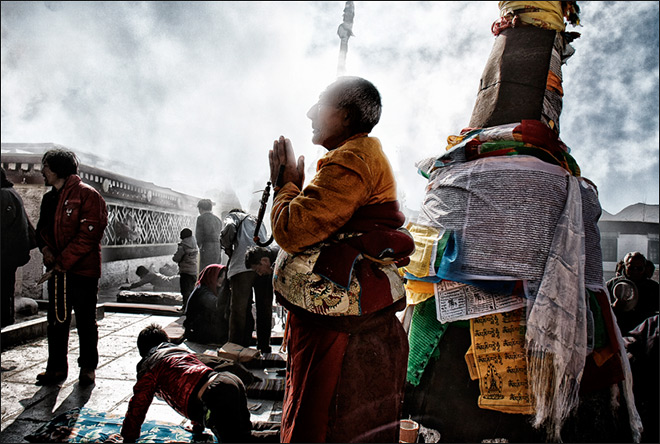 This is the forty eighth part in the series
This is the forty eighth part in the series The China Chronicles.
Read all the articles here.
China has a significant opportunity to resolve its conflict with Tibet. Before understanding why this dispute remains unresolved, one needs to understand the conflict. Following a brief military conflict between China and Tibet at the start of the 20th century, Tibet declared itself as an independent nation in 1912. It functioned as an autonomous region until 1950. In 1949, the Communists under Mao Zedong’s leadership gained power and in 1950 seized control of Tibet. In 1951, the Dalai Lama’s representatives signed a seventeen-point agreement that granted China sovereignty over Tibet for the first time. The Chinese claim that this document is proof of Chinese sovereignty over Tibet while Tibet says that it was coerced into signing this document.
The current Dalai Lama claims that he wants only autonomy for Tibet, because it would ensure the preservation of Tibet’s unique culture, language and customs. The Dalai Lama in 1959 fled Tibet to India after a failed uprising. The Chinese have little trust in the Dalai Lama and claim that his intentions are not sincere. Further China claims that Tibet has been an inalienable part of China since the thirteenth century under the Yuan Dynasty. The Tibetans’ stand is that the Chinese Empire was either a Mongol (Yuan) or a Manchu (Qing) one. It included China too. However, Tibet was a protectorate. The Tibetans provided spiritual guidance to the emperors in return for protection. In 1912, the Qing dynasty collapsed and Tibet declared independence. All Chinese officials and residents were expelled from Lhasa.
The current Dalai Lama claims that he wants only autonomy for Tibet, because it would ensure the preservation of Tibet’s unique culture, language and customs.
The Chinese blame the British for causing confusion in Tibet refusing to be bound by any treaties signed between Tibet and Britain during the early 20th century. This includes the 1914 Shimla convention where the British recognised Tibet as an autonomous area under the suzerainty of China. There is also differing contentions about what includes political Tibet in modern times. For the Chinese, this includes the Tibet Autonomous Region (TAR), which are the western and central areas. This was directly ruled by Tibet when the Chinese invaded Tibet in 1950. However, the Tibetan people who were exiled despite staking claims for a Greater Tibet, which includes TAR and the ethnic areas east of TAR. Tibet lost most of it in the 18th century. These areas formerly known as Amdo and Kham are located among parts of Chinese provinces of Sichuan, Qinghai, Yunnan and Gansu.
Following the Cultural Revolution, Mao sent the Chinese army to Tibet after they refused to accept the conditions which the Chinese authorities wanted to impose. The Tibetans looked to the West for help. However, Western nations refused to provide the same kind of assistance that Russia had provided to Mongolia. Then Tibet looked towards India, the United Kingdom and the United Nations for help. Both the UK and India took the stand that the Tibet issue should figure in discussions in their Parliaments. Mao’s Cultural Revolution in Tibet continued until 1976. After Deng Xiaoping took over in 1978, he reached out to the Dalai Lama in a quest to foster a reconciliatory economic and cultural policy towards Tibet.
 Source: 亚楠 李/CC BY-NC 2.0
Source: 亚楠 李/CC BY-NC 2.0
Pro-independence protests in Tibet started in 1987 and this led to a clampdown by the Chinese authorities on religious and cultural freedom in Tibet. Simultaneously, a rapid economic development programme was formulated leading to large immigration of Hans Chinese into Tibet. The Dalai Lama’s exile in Dharamsala in Northern India in 1959 put India squarely at the centre of this China-Tibet dispute. India is currently home to around 120,000 Tibetans. As for the US, it did more to confuse the issue by providing covert support to insurgents through the CIA through the 1950s and 1960s, and then abruptly stopping their support in 1971 when Richard Nixon wanted to improve relations with China.
Pro-independence protests in Tibet started in 1987 and this led to a clampdown by the Chinese authorities on religious and cultural freedom in Tibet. As for the US, it did more to confuse the issue by providing covert support to insurgents through the CIA through the 1950s and 1960s, and then abruptly stopping their support in 1971.
Some have criticised the Dalai Lama’s strategy. After the unexpected death of the Panchen Lama on 28 January 1989, the Dalai Lama was invited to China. The Chinese held the view that it was easier to negotiate with the Dalai Lama than his advisors. Unfortunately, the Dalai Lama did not accept the invite. The thought process might have been that it might dishearten the Tibetans and because of the fear that he might be mistreated. Whatever the reasons were, some have suggested that this was one of the lost opportunities in the post-1978 era. Additionally, there was controversy involving the selection of the Panchen Lama following the demise of his predecessor. The new Panchen Lama was to be elected through the Golden Urn process, which was a kind of a lottery process commenced by the Qing dynasty in 1792.
The complication happened due to the fact that the Chinese initially gave no role to the Dalai Lama while the latter rejected the Golden Urn process and took the stand that ultimately it would be decided by him as to who the next Panchen lama would be. Subsequently, the Chinese decided that it would be better to follow a conciliatory process initially select the Lama and later have him approved by the Dalai Lama. The Dalai Lama expressed favour for this initiative since he wanted to avoid a total confrontation with China. In order to make the process easier, the Chinese officials did permit Tashilhunpo’s monastery’s (monastery of the Panchen Lama) Chadrel Rimpoche, who was the head of the search team for the Panchen Lama, to make contact with the Dalai Lama. Chadrel Rimpoche made a request to that effect in the form of a letter. However, the Dalai Lama asked him to come to India for negotiations. At the end of 1994, the search team compiled a list of 25 candidates to select the next Panchen Lama.
Chadrel Rimpoche wrote mentioning that indications point towards Gendun Choekyi Nyima as the new Panchen Lama. During the first few months of 1995, the Dalai Lama examined the evidence and concluded that the boy had all the desired qualities to become the next Panchen Lama. Meanwhile, Chadrel Rimpoche sought to persuade the Chinese officials that the golden Urn process should not be used. The Dalai Lama meanwhile announced on 14 May 1995 that he recognised Gendun Choekyi Nyima as the new Panchen Lama. This upset the Chinese. Following this, Chadrel Rimpoche was arrested for leaking secrets to the Dalai Lama, arrested and sent to prison for six years. Gendun was rejected and another selected. The entire process collapsed.
The West and the rest of the world hold a positive view of Tibetans. China has an advantage, except for the very radical elements, no one in Tibet demands total independence.
The Tibetans have generally used non-violence as a means to secure their rights. Thus, the West and the rest of the world hold a positive view of Tibetans. China has an advantage, except for the very radical elements, no one in Tibet demands total independence. Right now, there is a fear in China that if they provide independence to Tibet the Uighurs and Taiwanese will demand the same. Some Chinese officials claim they are just waiting for the Dalai Lama’s expiry for the Tibetan movement’s intensity to subside. There is a risk that after the Dalai Lama, the Tibetan movement might turn violent. It is an issue mandating Chinese analysis and introspection.
One of the major criticisms facing China is its conflict with most of its neighbours. Beijing has done little to reconcile with them. The Tibet issue is just one among the thorns that China has been facing along with Taiwan, Hong Kong, and with the Uighur Muslims in Xinjiang. In the South China Sea, China, Vietnam, Philippines, Taiwan, Malaysia and Brunei all have claims. Added to this is the East China Sea conflict where China, Japan and South Korea have disputes. A large part of the world sees China as a threat. Resolving the Tibetan conflict by providing at least limited autonomy after negotiations with the Dalai Lama would increase the governing legitimacy of the ruling Communist Party of China (CPC) enormously. As rising global power, legitimacy is key to sustaining its credibility. A resolution of the Tibet problem would go a long way in enhancing China’s global power credentials.
The views expressed above belong to the author(s). ORF research and analyses now available on Telegram! Click here to access our curated content — blogs, longforms and interviews.



 This is the forty eighth part in the series The China Chronicles.
Read all the articles
This is the forty eighth part in the series The China Chronicles.
Read all the articles  Source:
Source:  PREV
PREV


